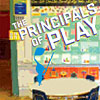The Principles of Play [Metropolis Magazine]
The article takes as an example Game Designer, an educational software program currently under development that introduces junior high school kids to the craft of video-game design.
“Part of a three-year research and development project backed by a $1.2 million grant from the John D. and Catherine T. MacArthur Foundation, the program’s loftier goals are to help equip students with a foundation of technical, artistic, cognitive, and linguistic skills—which some educational researchers argue are neglected by current standardized test-based curricula.”
“The educational aspect of the design is being overseen and tested by the University of Wisconsin’s Games and Professional Practice Simulations Group (GAPPS). Leading the GAPPS group is Jim Gee, a sociolinguist and professor at the University of Wisconsin–Madison whose several books include the pleasingly provocative What Video Games Have to Teach Us About Learning and Literacy. Gee is an engaging thinker and avid gamer who discovered video games in his early fifties.”
“In the appendix to What Video Games Have to Teach Us, Gee lists 36 learning principles that he believes are built into video games. His argument is not that video games are good teachers, but that playing good video games is often good learning. […] Play, according to Gee, requires a four-step process of probing, hypothesizing, reprobing, and then rejecting or accepting the hypothesis—the very foundation of the scientific method. […] Gee [also] rgues that video-game players naturally form “affinity groups†for sharing goals, endeavors, and practices, often across cultural and ethnic divides.”
Interestingly, the article then continues discussing whether more established design disciplines learn something from game design.
“Games are played for no other reason than for the experience of playing them—unlike a software application, in which the experience or enjoyment of the user is a by-product. If the experience of the interface is not pleasing, players will walk away. By contrast, the interfaces of many cell phones, software applications, digital cameras, microwave ovens, cars, and even wayfinding systems are maddening to use. In some situations—famously the VCR—the interface has been bad for so long that we expect operation to be frustrating and difficult. “
“A good game interface will not bombard the user with information at the outset or rely on a complex instruction manual; it will teach the user everything he or she needs to know on a need-to-know basis. This convention is so entrenched, in fact, that gamers trust the system and never read the manuals. Figuring out how it works, whether it’s boosting your cyborg hero’s bomb-disposal skills or downloading a cheat code that makes her invisible to flying aliens, is part of the game. “A game’s system itself generates meaning, and the way it changes over time begins to modify your understanding of that system,†Salen [a game designer and the director of the graduate Design and Technology Program at Parsons School of Design in New York] says. “It’s a basic principle that can apply to all kinds of design.â€





[…] Nell’articolo ‘The Principles of Play’ pubblicato su Metropolis Magazine, Peter Hall fa delle riflessioni su come comunicare con una generazione di studenti cresciuti con la tecnologia e resistenti ai tradizionali metodi di insegnamento attraverso un design innovativo dei giochi. […]
[…] – The Principles of Play – Sito di Living Labs Europe – Blog di Living Labs Europe – Brochure di Living Labs Europe (pdf, 467 kb, 8 pages) […]